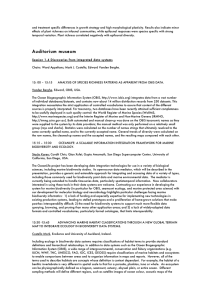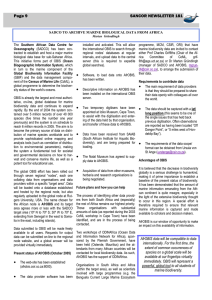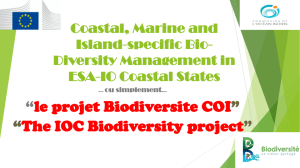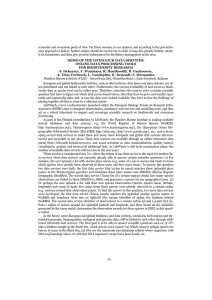INFORMATION DOCUMENT
advertisement
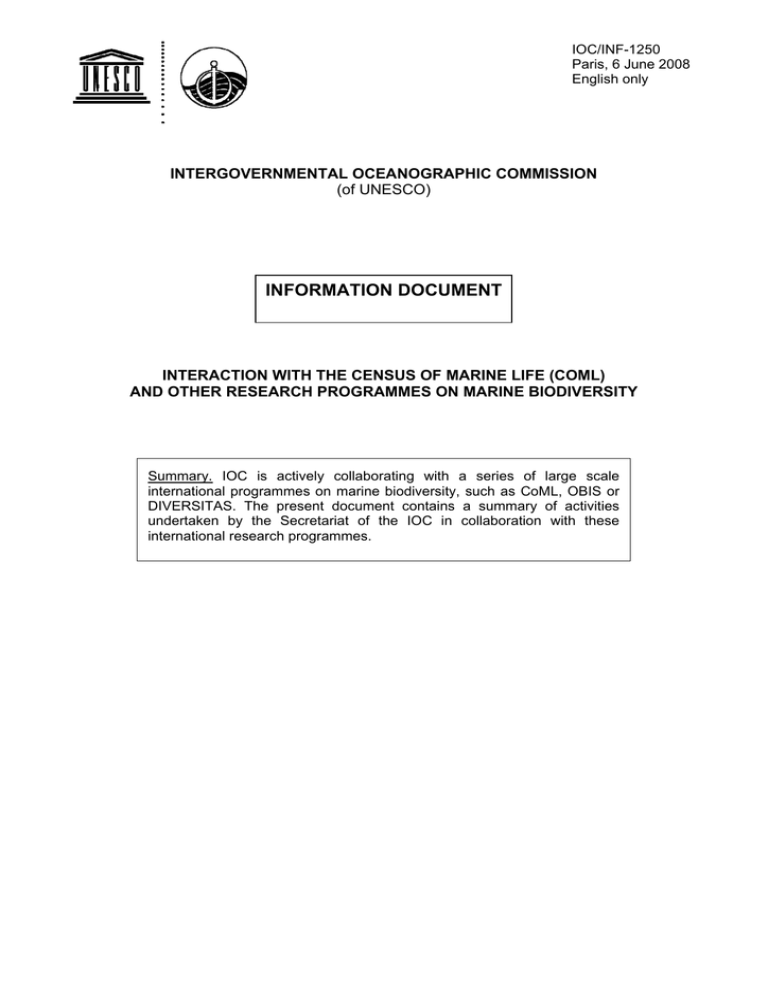
IOC/INF-1250 Paris, 6 June 2008 English only INTERGOVERNMENTAL OCEANOGRAPHIC COMMISSION (of UNESCO) INFORMATION DOCUMENT INTERACTION WITH THE CENSUS OF MARINE LIFE (COML) AND OTHER RESEARCH PROGRAMMES ON MARINE BIODIVERSITY Summary. IOC is actively collaborating with a series of large scale international programmes on marine biodiversity, such as CoML, OBIS or DIVERSITAS. The present document contains a summary of activities undertaken by the Secretariat of the IOC in collaboration with these international research programmes. IOC/INF-1250 1. INTRODUCTION The IOC Medium-Term Strategy 2008–2013 identified the safeguarding the health of ocean ecosystems as one of its High-Level Objectives, to be pursued through actions aimed to (i) actively contribute to the Regular Process for Global Reporting and Assessment of the State of the Marine Environment, including Socioeconomic Aspects; (ii) further develop the research and monitoring required for the prevention of marine environment degradation, and the maintenance of biodiversity and the sustainable use of marine habitats; and (iii) identify and develop the capacity-building necessary for maintenance of healthy ocean ecosystems focusing on the regional needs. In this context, and in the light of the preparatory work for defining the biennial strategic priorities and the main axes of the Programme and Budget for 2008–2009, IOC is in the position to consider a continuing and strengthened role in the coordination and sponsoring of international science programmes addressing, through multidisciplinary approaches, the biotic components of marine ecosystems; among these programmes are the Global Ocean Ecosystem Dynamics – GLOBEC, the Integrated Marine Biogeochemistry and Ecosystem Research (IMBER), and the Census of Marine Life (CoML), DIVERSITAS and GOODS. This document highlights the existing cooperation with these important scientific programmes in the context of the monitoring of the large-scale biomes of the Open Ocean as well as research in the coastal large marine ecosystems. 2. CENSUS OF MARINE LIFE The stated purpose of the Census of Marine Life is to assess and explain the diversity, distribution, and abundance of marine life. Each plays an important role in what is to known, unknown, and may never be known about what lives in the global ocean. First, diversity. The Census aims to make for the first time a comprehensive global list of all forms of life in the sea. No such unified list yet exists. Census scientists estimate that about 215,000 species of marine animals have been described and reside in jars in collections in museums of natural history and other repositories. Since the Census began in 2000, researchers have added more than 5600 species to the lists. They aim to add many thousands more by 2010. The database of the Census already includes records for more than 14 million species, old and new. By 2010, the goal is to have all the old and the new species in an on-line encyclopedia with a webpage for every species. In addition, we will estimate how many species remain unknown, that is, remain to be discovered. The number could be astonishingly large, perhaps a million or more, if all small animals and protests are included. For comparison, biologists have described about 1.5 million terrestrial plants and animals. Second, distribution. The Census aims to produce maps where the animals have been observed or where they could live, that is, the territory or range of the species. Knowing the range matters a lot for people concerned about, for example, possible consequences of global climate change. Third, abundance. No Census is complete without measures of abundance. We want to know not only that there is such a thing as a Madagascar crab but how many there are. For marine life, populations are being estimated either in numbers or in total kilos, called biomass. The Census has evolved a strategy of 14 field projects to touch the major habitats and groups of species in the global ocean. Eleven field projects address habitats, such as seamounts or the Arctic Ocean. Three field projects look globally at animals that either traverse the seas or appear globally distributed: the top predators such as tuna and the plankton and the microbes. The projects employ a mix of technologies. These include acoustics or sound, optics or cameras, tags placed on individual animals that store or report data, and genetics, as well as some actual capture of animals. The technologies complement one another. Sound can survey large areas in the IOCINF-1250 – page 2 ocean, while light cannot. Light can capture detail and characters that sound cannot. And genetics can make identifications from fragments of specimens or larvae where pictures tell little. The IOC has strengthened its collaboration mainly through GOOS, IODE and HAB with mainly two programmatic elements of the Census, specifically (i) the Ocean Tracking Network (OTN), a large-scale global initiative that comprehensively monitors ocean conditions and marine life response to these conditions and is affiliated as a GOOS pilot project; and (ii) the Ocean Biogeographic Information System (OBIS) initiative which is the information and data component of the Census. Background on OBIS OBIS was established by the Census of Marine Life programme (www.coml.org). It is an evolving strategic alliance of people and organizations sharing a vision to make marine biogeographic data, from all over the world, freely available over the World Wide Web. It is not a project or programme, and is not limited to data from CoML-related projects. Any organization, consortium, project or individual may contribute to OBIS. OBIS provides, on an ‘open access’ basis through the World Wide Web: (i) taxonomically and geographically resolved data on marine life and the ocean environment; (ii) interoperability with similar databases; and (iii) software tools for data exploration and analysis. OBIS was one of the earliest Associate Members of the Global Biodiversity Information Facility (www.gbif.org) which publishes data on all species. OBIS is a very active participant in GBIF activities, and one of the largest publishers of data to GBIF, reflecting its role as a specialist network for marine species. GBIF recommends that marine data are first published through OBIS, because OBIS can add special value (e.g. depth) and will manage the subsequent publication of data through GBIF. This also avoids duplication of data being separately published to GBIF and OBIS. Any organization, consortium, project or individual may contribute to OBIS. Contributions typically take the form of publishing data through OBIS, or providing software tools. The data may be published through an on-line connection from another database or be located on the OBIS server at a Regional OBIS Node or at Rutgers, The State University of New Jersey. OBIS is managed by a Governing Board with advice from the CoML Steering Committee and with the OBIS Managers Committee and Chairs of the OBIS Working Groups. The first meeting was held on 28 and 29 April 2008 in Rome. The IOC Executive Secretary is a member of the OBIS Governing Board. The Executive Director reports to the governing Board, coordinates OBIS activities, and manages the Secretariat and Portal. The Executive Committee is a sub-group of the Governing Board and oversees implementation of activities between meetings. The Executive Director is currently based at Rutgers University, Institute for Marine and Coastal Sciences, New Brunswick, New Jersey, USA. Support for OBIS is provided by the Alfred P. Sloan Foundation, European Commission, Gordon and Betty Moore Foundation, National Science Foundation (NSF), National Oceanographic Partnership Program (NOPP), and National Oceanic and Atmospheric Administration (NOAA). Support for the Secretariat of the Executive Director is provided mainly by the Alfred P. Sloan Foundation. However this support will end in 2010 which has led to the need for alternative support arrangements. During the First Session of the OBIS Governing Board the issue of “Making OBIS selfsustained” was discussed. The Governing Board has expressed strong interest in a close alliance with IOC. This alliance takes different forms ranging from a loose agreement on cooperation to IOC “adopting” OBIS as an IOC programme. IOCI/INF-1250 – page 3 OBIS and IOC In the context of IODE attention was given to biological data management and ocean biodiversity since IODE-XVI (2000) with the creation of the IODE Group of Experts on Biological and Chemical Data Management and Exchange Practices (GE-BICH; Recommendation IODEXVI.4). During IODE-XVII (2003) an invitation was extended to OBIS to participate in the activities of the Group of Experts. The OBIS Executive Officers have been participating in meetings of the Group since then. The strong interest of IODE in biological data management and ocean biodiversity was further demonstrated by the organization of the “Colour of Ocean Data” Symposium in November 2002 (IOC Workshop Report 188). The focus of IODE on ocean biodiversity continued with the organization of the “Ocean Biodiversity Informatics Conference” in Hamburg, 2004 and Dartmouth, 2007 which were organized jointly between IODE and OBIS. It should further be noted that IODE-XVIII (2005) and IODE-XIX (2007) revised the Terms of Reference of the IODE Group of Experts on Biological and Chemical Data Management and Exchange Practices (GE-BICH) to include: (i) documenting the systems and taxonomic databases and inventories currently in use in various data centres; (ii) documenting the advantages and disadvantages of different methods and practices of compiling, managing and archiving biological and chemical data; (iii) developing standards and recommended practices for the management and exchange of biological and chemical data, including practices for operational biological data; (iv) encouraging data centres to compile inventories of past and present biological and chemical data holdings; (v) encouraging data holders to contribute data to data centres for the creation of regional and global integrated oceanographic databases incorporating physical, chemical and biological data; (vi) creating and keeping updated GE-BICH web “portal” making all results from the GE’s work available to a wider community of data managers and data users; and (vii) contributing results of GE-BICH activity to Ocean Teacher making results from the GE and from other programmes available to education of data managers and data users. At the regional level there has been increasingly close collaboration between OBIS and IODE, e.g. within the framework of ODINAFRICA. The Chair briefed the meeting about the ODINAfrica contribution to the African node of the OBIS network, AfrOBIS. Two biodiversity data management training sessions were held, one in Ostend, Belgium (in French), one in Mauritius (in English). In these training sessions, attendees were introduced to issues in taxonomy and biogeography relevant to data managers, and to some of the tools that are used in marine biodiversity data management in general, and in the OBIS network in particular (Access, SQL Server, DiGIR). Two data logging sessions have been organized, both in Ostend. One focused on mollusks, one on sponges. Species distribution records extracted from the scientific literature during these logging workshops will be made available to AfrOBIS. At the international level the IODE/MarBEF Biodiversity Data Management Course was organized in March 2003. The course was specific for biodiversity data management, going into details on specific data needs for taxonomy and geography. The IOC Strategic Plan for Oceanographic Data and Information Management’s vision is for “A comprehensive and integrated ocean data and information system, serving the broad and diverse needs of IOC Member States, for both routine and scientific use”. Communication within and between IOC programmes, and with IOC’s partners, is essential to ensure that a fully integrated data system rather than the current multitude of systems results. As an immediate follow-up to the adoption of the Strategic Plan by the 24th Session of the IOC Assembly (2007), the IODE and HAB programmes decided to collaborate on the development of the “International Harmful Algal Information System”. But IOC does not exist in isolation and cooperation with other organizations with similar interests and goals is essential and within the scope of HAIS close collaboration therefore needs to be established with OBIS. In this regard the IOCINF-1250 – page 4 “Joint IPHAB/IODE Task Team on the development of the Harmful Algal Information System Design Workshop” was organized in January 2008 and was attended by the OBIS Executive Director, Dr Edward Vanden Berghe. Conclusions The above clearly illustrates that cooperation between IODE and OBIS is not new but has accelerated substantially in the past few years. The IOC programmes dealing with living resources as well as the IODE programme that, through the new Strategic Plan will have a core role of integrating the diverse data from many sources, will benefit substantially from a close alliance with OBIS. Looking at IODE the international network of 76 NODCs and DNAs will be enriched with a similar network of 14 Regional OBIS Nodes and over 200 “data providers”. IOC will also benefit from the advanced technological tools that have been developed by OBIS and its partners. These will contribute and complement initiatives such as the IODE Ocean Data Portal and the JCOMM Pilot Project for the WMO Integrated Global Observing Systems (WIGOS). The current invitation extended by OBIS offers a unique opportunity for IOC to expand and enrich its programme activities related to marine living resources. 3. DIVERSITAS In the context of DIVERSITAS – a programme on Integrated Biodiversity Science cosponsored by UNESCO, ICSU, IUBS and SCOPE, priority marine issues not covered in other core projects of DIVERSITAS or requiring the involvement of scientists and institutions from developing countries were organized in the context of a work plan developed by the DIVERSITAS Marine Biodiversity Task Force, of which IOC and UNESCO hosted one meeting in May 2007. The work plan encompasses the following elements: marine microbial biodiversity; marine coastal biodiversity; conservation and sustainable use of marine biodiversity on the areas beyond national jurisdiction; and the IOC and UNESCO input to the Diversitas Marine Crosscutting Network. The work plan recognizes that IOC and the Division of Ecological and Earth Sciences of UNESCO have a standing mandate to contribute to coordination of international programmes in marine sciences, in light of IOC’s role in promoting harmonization of international marine scientific programmes and activities, some of which are implemented in a decentralized manner, while others are coordinated by the IOC itself and its partners, like the World Climate Research Programme (WCPR). Current programmes and activities that are relevant to the DIVERSITAS Marine Biodiversity Crosscutting Network include observational networks (including on monitoring of seagrass ecosystems, the Harmful Algal Blooms (HAB) Programme, the Global Coral Reef Monitoring Network and IOC’s participation in a GEF project on coral reefs); the World Climate Research Programme, which includes coordinating the observation of ocean carbon fluxes; programme activities related to integrated coastal area management; and recently-completed activities on indicators for coastal management, indicators of benthic diversity and of coral bleaching and assessments of changes in ocean geochemistry. UNESCO/SC-EES provides the Secretariat to the Man and the Biosphere Programme, which includes a World Network of Biosphere Reserves of more than 500 sites in more than 100 countries; approximately 80 of these are coastal marine sites, to be found is some 30 countries, for which opportunities to link these sites with relevant scientific networks – namely, the marine networks of excellence under the European Commission and the European network of Marine Research Stations (MARS) – are being explored. Another opportunity for linking the DIVERSITAS Marine Biodiversity Crosscutting Network with UNESCO and IOC programmes and activities is represented by the UNESCO Chairs Programme. There is a continued need to inform the policy-related intergovernmental activities of IOCI/INF-1250 – page 5 UNESCO and IOC with the best scientific knowledge available, hence the relevance of the DIVERSITAS Marine Biodiversity Crosscutting Network. Several issues of concern to Members of IOC and Member States of UNESCO require further scientific elucidation, especially in the coastal ocean. At a substantive level, the scientific priority of marine microbial biodiversity, the work plan recognizes that microorganisms are primary drivers of global element cycles and are essential for the functioning of all ecosystems on earth. They contribute substantially to the productivity of oceanic and continental ecosystems. Relevant functions of environmental microbial communities include remineralization, transformation of energy, biomass production, detoxification, production and destruction of greenhouse gases, CO2 sequestration, symbiosis and pathogenesis with plants and animals, including humans. However, the interconnection between microbial diversity, distribution and the metabolism, productivity and functionality of ecosystems remains largely unknown – in terrestrial as well as aquatic habitats. Since microbial organisms may make up >90% of the ocean’s biomass and primary productivity, and comprise a yet unknown diversity of genetic information and metabolic capacity which exceeds that of animals and plants by far, discovering the diversity of marine microbes is the first step towards a better understanding of ocean life in general and a high priority task for marine biodiversity studies. Planned work includes: (i) assessing microbial diversity using genetic approaches for discovery of microbial diversity in the marine environment; (ii) cooperation with other biodiversity initiatives, namely work related in the context of the Census of Marine Life programme International Census of Marine Microbes (CoML-ICOMM). Collaborative programs also include the US programs LExEn (Life in Extreme Environments, NSF), the RIDGE program (NSF), Microbial Observatories (NSF), and Biocomplexity (NSF), as well as European Community programmes such as MARBEF, Marine Genomics and HERMES; (iii) monitoring microbial biodiversity change, which reflects the need to develop new methodologies for monitoring, understanding and predicting microbial biodiversity change, using mainly genetic analyses and environmental microbiological monitoring approaches including optical methodologies (e.g. flow cytometry, spectral analyses) and nanotechnology and microfluidics for the interfacing of optical technology and field sampling, e.g. for mounting on buoys. Remote sensing from aircraft or satellites also has the potential to observe and monitor particular taxonomic groups, especially pigmented cells. The DIVERSITAS marine element will also deal with the study of how ecological functions and services can be maintained in the face of local human disturbances interacting with large-scale climate processes in the marine coastal environment, building largely on the CoML Natural Geography in Near Shore Areas project. The overarching question is to what extent climate change and resource depletion can affect the functioning of marine coastal ecosystems by driving changes in biodiversity. This can be broken down into more refined questions: (i) How much of the observed variation in the distribution and abundance of species can be ascribed to climate events, local anthropogenic disturbances and their interactions? (ii) What is the relative importance of an overall reduction in species richness (species complementarity) vs the loss of particular species (species identity) in driving the relationship between biodiversity and ecosystem functioning in marine coastal habitats? (iii) Does an increase in frequency of extreme climate events affect ecosystem stability and resilience? (iv) To which extent are the effects of climate extremes on ecosystem functioning modulated by biodiversity? Finally, the part of the marine element of DIVERSITAS dealing with conservation and sustainable use of marine biodiversity on the areas beyond national jurisdiction will attempt at synthesizing and providing new knowledge in support of relevant policy process dealing with the biodiversity to be found in these areas. IOCINF-1250 – page 6 4. BIOGEOGRAPHIC CLASSIFICATION OF THE GLOBAL OPEN OCEANS AND DEEP SEABED (GOODS) A report on the biogeographic classification of the Global Open Oceans and Deep Seabed (GOODS) was produced by a multidisciplinary scientific expert group, who started this task at workshop in Mexico City in January 2007. The workshop was co-sponsored by: the Australian Government through the Australian Department of the Environment, Water, Heritage and the Arts; the Canadian Government through the Canadian Science Advisory Secretariat, Fisheries and Oceans Canada; the JM Kaplan Fund; the Universidad Nacional Autonoma de México (UNAM); Mexico’s National Commission for the Knowledge and Use of Biodiversity (CONABIO); the Intergovernmental Oceanographic Commission; UNESCO’s Division of Ecological and Earth Sciences; and IUCN. The pelagic and benthic biogeographic classifications presented in the report represent the first attempt at comprehensively classifying the open ocean and deep seafloor into distinct biogeographic regions. This biogeographic classification is based on a physiognomic approach, which uses environmental characteristics of the benthic and pelagic environments to select homogeneous regions of similar habitat and associated biological community characteristics. In other words, it classifies specific ocean regions by their defined environmental features (structural features of habitat, or ecological functions and processes) and —to the extent data are available— their species composition. This work is hypothesis-driven and still preliminary; it has benefited from peer-review from a number of experts and will continue being further refined and peer reviewed in the future. In its present format, the report provided a basis for discussions that can assist policy development and implementation in the context of the Convention on Biological Diversity (CBD) and other fora. In fact, the report was presented at, and well received by, the 13th meeting of the Subsidiary Body on Scientific, Technical and Technological Advice (SBSTTA), to the CBD; the 9th meeting of the Conference of the Parties (COP) to the CBD; and the second meeting of the UN Ad Hoc Open-Ended Informal Working Group to study issues relating to the conservation and sustainable use of marine biological diversity beyond areas of national jurisdiction (New York, 28 April–2 May 2008). Biogeographic classification is an important tool that will help us understand the distribution of species and habitats for the purposes of scientific research, conservation and management, and is therefore of importance to policy. A biogeographic classification will assist us in understanding the scales for ecosystem-based management and in identifying areas representative of major ecosystems. While clearly needing further refinement, the major open ocean pelagic and deep sea benthic zones presented in the report are considered a reasonable basis for advancing efforts towards the conservation and sustainable use of biodiversity in marine areas beyond the limits of national jurisdiction in line with a precautionary approach. The experts that authored the report concluded that any further refinement to biogeographical provinces need not delay action to be undertaken towards this end, and that such action be supported by the best available scientific information. The report is being published in its final form by UNESCO and IOC and will be available in October 2008. 5. WORLD CONFERENCE ON MARINE BIODIVERSITY (Valencia, Spain, 11–15 November 2008) Human activities have impacted on the structure and functioning of marine coastal ecosystems and communities. The combined effects of global scale changes in anthropogenic nutrient inputs to coastal ecosystems and studies of the composition of macrospecies communities as well as of genetic variability of marine microbial communities in coastal environments show that such alterations are undergoing and continue causing changes in marine coastal ecosystems. IOCI/INF-1250 – page 7 ‘Top-down’ effects of human activities, such as fisheries, combined with ‘bottom-up’ alterations of ocean biochemistry need to be further studied if appropriate policy decisions are to be taken on the sustainable management of marine coastal ecosystems and biodiversity. In the above-described context, IOC and UNESCO-MAB have decided to convene a special session at the World Conference on Marine Biodiversity (Valencia, Spain, 11–15 November 2008) on ‘Emerging paradigms in coastal research and related management and policy implications’. The UNESCO-IOC session at WCMC will deal with, in particular, emerging paradigms in coastal research, and the related scientific rationale, that may have to be further elaborated and tested, so as to increase the effectiveness of sustainable management options in the marine coastal areas of the world in light of the need to continue adapting to global and climate change. The sponsorship of IOC and UNESCO-MAB will allow the participation of developing country scientists in the session and the Conference as a whole. IOCINF-1250 – page 8 Intergovernmental Oceanographic Commission (IOC) United Nations Educational, Scientific and Cultural Organization 1, rue Miollis 75 732 Paris Cedex 15, France Tel.: +33 1 45 68 10 10 Fax: +33 1 45 68 58 12 http://Ioc.unesco.org


